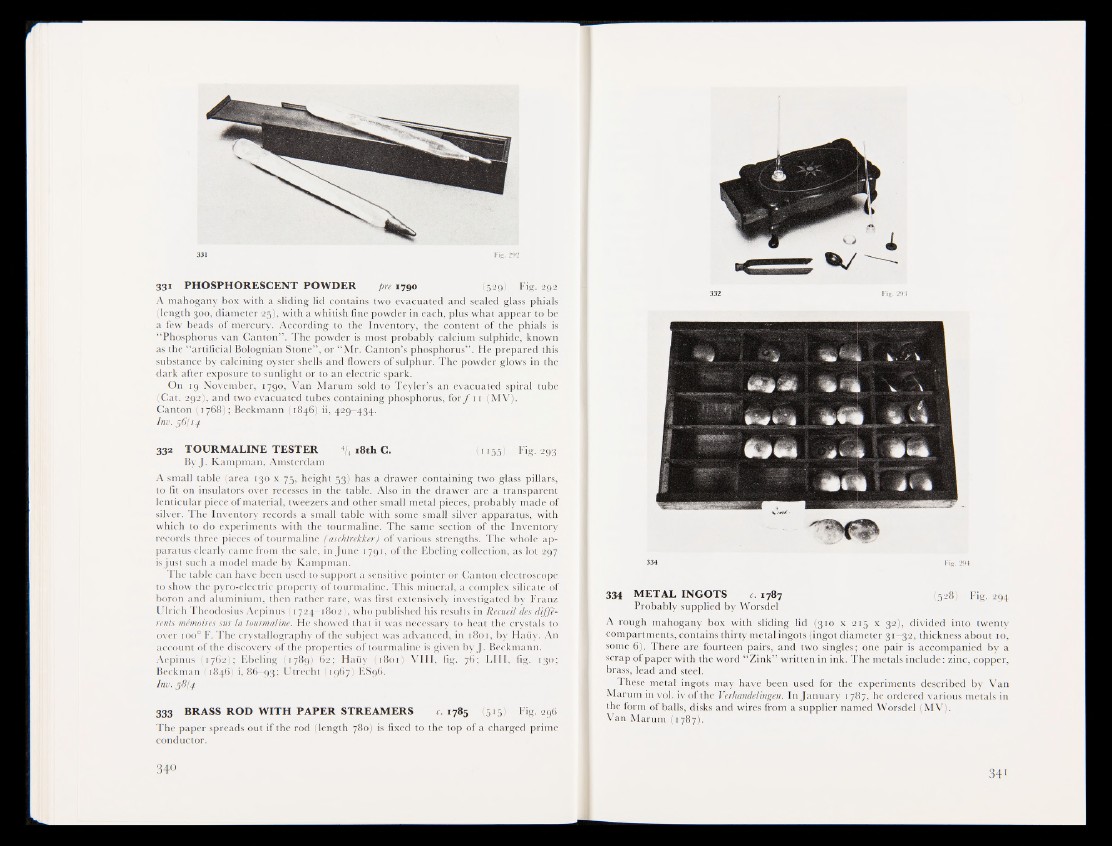
331 PHOSPHORESCENT POWDER pre 1790 (529) Fig. 292
A mahogany box with a sliding lid contains two evacuated and sealed glass phials
(length 300, diameter 25), with a whitish fine powder in each, plus what appear to be
a few beads of mercury. According to the'.Inventory, the content of the phials is
“ Phosphorus van Canton” . The powder is most probably calcium sulphide, known
as the “ artificial Bolognian Stone” , or “ Mr. Canton’s phosphorus» He prepared this
substance by calcining oyster shells and flowers of sulphur. The powder glows in the
dark after exposure to sunlight or to an electric spark.
On 19 November, 1790, Van Marum sold to Teyler’s an evacuated spiral tube
(Cat. 292), and two evacuated tubes containing phosphorus, forf 11 (MVI^M
Canton (1768); Beckmann (1846) ii, 429—434.
Inv. 56/14
332 TOURMALINE TESTER % 18th C. (1155) Fig.. #93
By J. Kampman, Amsterdam
A small table (area 130 x 75, height 53) has a drawer containing two glass pillars,
to fit on insulators over recesses in the table. Also in the drawer are a transparent
lenticular piece of material, tweezers and other small metal pieces, probably made of
silver. The Inventory records a small table with some small silver apparatus, with
which to do experiments with the tourmaline. The same section of the Inventory
records three pieces of tourmaline (aschtrekk&^k various strengths. The whole apparatus
clearly came from the sale, in June 1791, of the EbelingBolfection, as lot 297
is just such a model made by Kampman.
The table can have been used to support a sensitive pointer or Canton electroscope
to show the pyro-electric property of tourmaline. This mineral, a complex silicate of
boron and aluminium, then rather rare, was first extensively investigated by Franz
Ulrich Theodosius Aepinus (1724—1802), who published his results in Recueil dés différents
mémoires sur la tourmaline. He showed that it was necessary to heat the crystals to
over ioo° F. The crystallography of the subject was advanced, in 1801, by Haiiy. An
account of the discovery of the properties of tourmaline is given by J. Beckmann.
Aepinus (1762); Ebeling (1789) 62; Haiiy (1801) VIII, fig. 76; T ill, fig.. 130;
Beckman (1846) i, 86—93; Utrecht ' 1967);F.S96.
Inv. $8\4
333 BRASS ROD WITH PAPER STREAMERS c. 1785 (515) Fig. 296
The paper spreads out if the rod (length 780) is fixed to the top of a charged prime
conductor.
332 Fig. 293
3 3 4 Fig. 294
334 METAL INGOTS c. 1787 (528) Fig. 294
Probably supplied by Worsdel
A rough mahogany box with sliding lid (310 x 215 x 32), divided into twenty
compartments, contains thirty metal ingots (ingot diameter 31—32, thickness about 10,
Some 6H There are fourteen pairs, and two singlesgUone pair is accompanied by a
scrap of paper with the word “Zink” written in ink. The metals include: zinc, copper,
brass, lead and steel.
These metal ingots may have been used for the experiments described by Van
Marum in vol. iv of the Verhandelingen. In January 1787, he ordered various metals in
the form of balls, disks and wires from a supplier named Worsdel (MV).
Van Marum (1787).